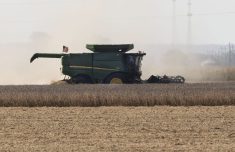CHICAGO, March 8 (Reuters) – Chicago Mercantile Exchange live cattle futures closed higher on Tuesday, after traders exited nearby positions to avoid taking delivery and packers seemed to be bidding more aggressively than expected in the U.S. southern Plains.
Traders said there was talk of Texas packers on Tuesday bidding in line with what they paid last week – and buying sooner this week than expected.
A week ago, packers in the U.S. Plains paid mostly $136 per cwt for cash cattle that in the previous week sold at $133 to $137, said feedlot sources.
Read Also

Trump mulls ending some trade ties with China, including in relation to cooking oil
U.S. President Donald Trump said on Tuesday Washington was considering terminating some trade ties with China, including in relation to cooking oil.
CME April live cattle contracts rose as high as 137.875 cents per pound, while June live cattle touched a two-month high during the day.
Packer margins on Tuesday remained down, though they showed some signs of improvement. The average beef packer margin was a negative $33.20 per head, compared with a negative $50.50 on Monday and a negative $61.25 last week.
“The packers are losing a little bit of money, but not a lot,” said AgriVisor Services analyst Dale Durchholz. In advance of spring grilling demand from retailers after the Easter holiday, “I don’t think [the packers] have a lot of good coverage in the forward mix.”
April live cattle closed up 1.175 cent per pound at 137.125 cents. June live cattle ended up 0.600 cent per lb to 126.675 cents.
March feeder cattle closed up 1.025 cent per lb to 158.975 cents.
Meanwhile, both cattle and hog futures were impacted when funds sold – or rolled – their April long positions and simultaneously bought deferred months, in a procedure known as the “roll” by followers of the Standard & Poor’s Goldman Sachs Commodity Index (S&PGSCI).
Such fund rolling pressured the April lean hogs contract, but not much on other months, traders said.
“Cash markets aren’t really that strong and they’re not really weak either, so you don’t have a lot of guys rushing in to counter” that roll, said Dan Norcini, an independent hog trader. “There’s no incentive right now to buy the April to aggressively counter that roll.”
The hog futures were helped in part from a cash hog market that remained mostly steady as growing demand from pork packers helped eat into ample supplies, said traders.
April closed 0.275 cent per lb lower at 69.775 cents, while May ended up 0.725 cent lower at 77.875 cents and June finished the day up 0.300 cent to 81.500.
















